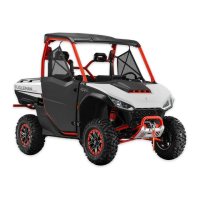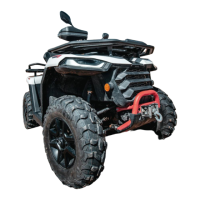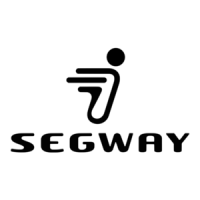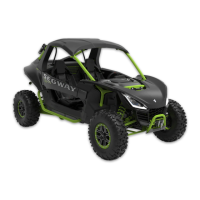
Do you have a question about the Segway FUGLEMAN UT10 2022 and is the answer not in the manual?
| Brand | Segway |
|---|---|
| Model | FUGLEMAN UT10 2022 |
| Category | Offroad Vehicle |
| Language | English |
Details on vehicle hang tags and warning labels for operator safety.
Critical safety guidelines to prevent serious harm or fatality.
Comprehensive safety guidelines for vehicle operation.
Emphasizes the necessity of reading the manual before operating the vehicle.
Specifies the minimum age and training required for safe vehicle operation.
Recommends essential protective gear for rider safety.
Warns against operating the vehicle under the influence of any impairing substances.
Advises against unauthorized modifications that may void the warranty.
Outlines safety procedures and capacity limits for carrying passengers.
Warns about the toxic nature of engine exhaust fumes.
Stresses the importance of proper seat belt usage for all occupants.
Emphasizes keeping cab doors securely closed and latched during operation.
Explains how cargo and passenger weight affects vehicle stability and handling.
Prohibits carrying passengers in the cargo or bed area of the vehicle.
Advises against operating on paved surfaces due to potential handling issues.
Prohibits the use of the vehicle on public streets, roads, or highways.
Warns about the increased risks associated with driving at excessive speeds.
Details the dangers of abrupt or improper turning maneuvers.
Discourages performing stunts or exhibition driving which increases accident risk.
Provides guidance on safe hill climbing techniques and precautions.
Warns against improper procedures when driving downhill.
Advises caution and proper techniques for driving across hillsides.
Critical safety instructions for handling gasoline and refueling.
Steps to activate the vehicle's DTS system using the mobile application.
Explains methods for unlocking the vehicle, including key and app options.
Overview of features and capabilities of the Segway Powersports mobile app.
Identifies external vehicle components and their labels.
Details the components and controls found on the vehicle's dashboard.
Instructions for operating the ignition and starting the vehicle's engine.
Explains the function and operation of various control switches.
Procedures for properly stopping and shutting down the vehicle.
Usage of the emergency switch for hazard warning lights.
Description of selectable driving modes (Sport, Economic).
Information on the switch that modifies speed limits in certain modes.
Operation of the 4WD system, including differential lock.
How to engage and disengage the 4WD system.
Operation of the lighting controls and horn.
Explains EPS system operation, warnings, and indicator lights.
Location and use of the 12V power outlets for accessories.
General information regarding the vehicle seats.
Instructions for adjusting the driver's seat position.
Procedures for removing and reinstalling the driver's seat.
Steps to remove the passenger seat for access.
Method for adjusting the height of the seat headrests.
How to adjust the tilt angle of the steering wheel.
Correct procedure for fastening and checking the seat belt.
Instructions for securing and checking the cab doors or safety nets.
Details on the installation and removal of the safety net.
Identification and use of various storage compartments.
Instructions for opening, closing, and safely refueling.
Explains the different gear positions (L, H, N, R, P) and their functions.
How to operate the brake and accelerator pedals for control.
Procedures for engaging and releasing the parking brake.
Information on the vehicle's rollover protection system and its importance.
Overview of the dashboard displays and indicators.
Interpretation of various warning lights and indicators on the instrument panel.
Explains diagnostic trouble codes for identifying system faults.
Fundamental principles and advice for operating the vehicle.
Guidelines for safe and respectful riding practices on trails.
Emphasizes understanding local terrain and environmental regulations.
Procedures for the initial break-in period to ensure component longevity.
Specific break-in guidelines for the braking system.
Recommended break-in procedure for the CVT belt and clutch.
Comprehensive steps for new operators before initial use.
Safety considerations and handling adjustments when carrying passengers.
Step-by-step instructions for starting the engine.
Correct procedures for parking the vehicle securely.
Essential techniques for effective braking in various conditions.
Safety precautions for parking the vehicle, including garage use.
Precautions and techniques for maintaining control on slippery terrain.
Guidelines and warnings for operating the vehicle in water.
Safety tips for maneuvering the vehicle in reverse.
Procedures for safely navigating over terrain obstacles.
Safe techniques and precautions for climbing inclines.
Safety advice and procedures for descending slopes.
Warnings and recommendations for driving on hillsides.
Steps for safely parking the vehicle on an incline.
Specific recommendations for the engine break-in period.
Essential pre-operation checklist to ensure vehicle safety and readiness.
Guidelines for safely loading, securing, and transporting cargo.
Tips for extending the operational life of the CVT belt.
Safety precautions and weight limits related to towing.
Specifications for the vehicle's maximum weight and cargo limits.
Procedures for safely operating the cargo box dump function.
General advice for securing cargo and operating the vehicle with loads.
Information on trailer attachment and towing considerations.
Safety precautions and operating instructions for the vehicle's winch.
Schedule and procedures for regular maintenance to ensure reliability.
Recommended oils, capacities, and intervals for lubrication.
Accessing components under the front service lid.
Information on the cargo box and its tailgate operation.
Instructions for raising and lowering the cargo bed.
Schedule and procedures for engine oil checks, changes, and filter replacement.
Specifies recommended engine oil type and viscosity grades for various temperatures.
Step-by-step guide for checking the engine oil level using the dipstick.
Detailed procedures for changing engine oil and the oil filter.
Instructions for draining engine oil from multiple locations.
Procedure for replacing the oil filter and cleaning the oil strainer.
Steps for cleaning the oil strainer.
Process for adding engine oil to maintain the correct level.
Maintenance schedule for demand drive fluid in the gearboxes.
How to check the oil level in the rear gearbox.
Procedures for changing the gearbox oil.
Instructions for adding gear oil to the front and rear differentials.
Procedures for replacing the CVT drive belt and related components.
Method for drying the CVT system if it becomes wet.
Recommended spark plug type, gap, and torque specifications.
Guide on inspecting spark plug condition to assess engine performance.
Information on the engine cooling system and the importance of coolant.
How to check and refill the coolant reservoir.
Recommendations for radiator coolant maintenance and periodic system flush.
Overview of the hydraulic disc brake system, including inspection points.
How to check and maintain the brake fluid level, including warnings.
Information on brake pad wear and criteria for replacement.
Guidelines for tire pressure, tread depth, and replacement.
Recommended tire inflation pressures for front and rear wheels.
Methods for checking tire tread wear and identifying replacement needs.
Conditions that necessitate tire replacement, such as damage or leaks.
Procedure for replacing worn or damaged tires.
Step-by-step instructions for removing a vehicle wheel.
Recommended tire sizes for optimal vehicle performance and safety.
How to adjust the spring tension of the shock absorbers for ride comfort.
Identification of grease fittings and lubrication points for suspension and drive components.
Inspection of drive axle dust boots for damage or grease leaks.
Information on the air filtration system and replacement of filter elements.
Procedures for changing the air filter element.
Daily checks for the air filter inlet cap and CVT mesh fabric.
Information on vehicle lighting systems and bulb replacement.
Instructions for replacing headlight bulbs.
Procedures for replacing taillight and rear turn signal bulbs.
How to adjust the aim of the headlight beams.
Maintenance of the spark arrester to prevent carbon accumulation and ensure performance.
Safety precautions and information related to the vehicle's 12V battery.
Steps for safely removing the vehicle battery.
Precautions and instructions for charging the 12V battery.
Correct procedures for installing the vehicle battery.
Explanation of the fuse system and procedures for checking and replacing fuses.
Location and access instructions for the vehicle's fuse box.
Diagram and list of fuses and relays with their circuit functions and power ratings.
How to use the provided tool to replace fuses in the fuse box.
Recommendations for maintaining the vehicle's exterior appearance.
Safe procedures for washing the vehicle to prevent damage.
Guidelines for proper storage when the vehicle is not in use.
Detailed technical specifications including dimensions, weights, and capacities.
Location to record VIN and engine serial numbers for reference.
Information displayed on the vehicle's frame nameplate.
Solutions for common issues related to the drive belt and its cover.
Troubleshooting steps for when the engine fails to crank.
Identifying causes and solutions for engine detonation or knocking.
Diagnosing and resolving engine stalling or power loss issues.
Troubleshooting steps when the engine cranks but does not start.
Causes and troubleshooting for engine backfiring.
Steps to diagnose and fix engine running issues like rough idle or misfires.
Explanation of the origins and nature of exhaust emissions.
Details on the system designed to control exhaust emissions.
Description of the system preventing crankcase emission release.
Information on meeting local noise level regulations.
Overview of warranty terms, owner responsibilities, and coverage.
Specifics of the limited warranty duration and transferability.
What is not covered by the warranty, such as wear items.
Lists specific conditions and circumstances excluded from warranty coverage.











